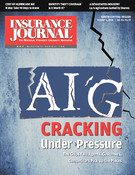Texas’ top insurance regulator told lawmakers on Sept. 24 that the industry estimates there will be around 300,000 property claims — including commercial property claims — stemming from Hurricane Ike, which hammered Texas on Sept. 13. Around 40 to 50 percent of those claims — around 120,000 to 140,000 — will go to the Texas Windstorm Insurance Association, Insurance Commission-er Mike Geeslin told the Texas Sunset Advisory Commission at a hearing in Austin.
Geeslin said it is too early to know the total dollar amount of Ike claims, noting that insurance adjusters are just now being able to access the heavily damaged areas along the coast. Geeslin said despite estimates released by catastrophe modeling firms, which put the cost of the storm between $6 billion and $18 billion, it will take 30 to 90 days before the true impact of the hurricane will be known.
As of the afternoon of Sept. 24, TWIA — the state chartered insurer of last resort — had fielded more than 46,000 claims from Ike. “I estimate after talking to [TWIA] General Manager Jim Oliver that will be at 50,000 by days end,” Geeslin said. “These are coming in by the thousands on a half-day basis.”
Geeslin explained that TWIA estimates claims for the windpool will come in around $3 billion to $4 billion but noted those numbers are “fluid.” It’s “sobering to realize how much the state is on the hook,” Geeslin said.
“TWIA has currently put up reserves for incurred losses of over a billion [dollars,]” Geeslin said. In addition, TWIA’s board recently voted to assess member companies $430 million, although TWIA management was seeking $830 million. Around “$230 million of the $430 million will be subject to premium tax credits over a five-year period. This is just the initial assessment,” Geeslin said. He pointed out that a second or even a third assessment will likely be necessary to cover all of TWIA’s claims.
‘Rates Must Be Justified’
Geeslin said compared with previous years, insurers’ loss ratios will be worse “for this calendar year and the first three quarters of 2009,” due to losses from Hurricane Ike and other storms. But he said dire warnings that rates will skyrocket due to carrier losses this year are “overstatement.”
During the previous four years carriers have had good loss ratios, Geeslin explained. Therefore, he said, the market should not jump to conclusions regarding rate increases.
Hurricane Ike “is the event we have all anticipated would happened,” he said, and most companies have allowed for the possibility of such a catastrophe in setting their rates. The built-in catastrophe loads vary from company to company, Geeslin added.
“The point is it’s not as if most companies have ignored this type of year coming and most companies have made provisions for it in their rate structures,” he said.
As far as market impact from Hurricane Ike, tighter underwriting restrictions and a reduced willingness to write in Tier 2 counties will likely result. “You can only put wind risk in TWIA in Tier 1 counties,” Geeslin said. So in Tier 2 counties, like a portion of Harris County and Fort Bend County, commercial risks are especially likely to feel the pinch. In those counties there was a “tightening in the market for commercial risk already. I think that will be amplified,” he said.
Ultimately, “rates must be justified,” Geeslin said. Carriers “can’t just hit the hysteria button and offer something that has no actuarial or economic justification whatsoever.”
The position of the insurance department and the Office of Public Insurance Counsel is that they are there to maintain the stability of the market and to “make sure consumers are treated fairly,” he said.
Topics Catastrophe Texas Claims Hurricane
Was this article valuable?
Here are more articles you may enjoy.


 Ford Recalls 668,000 2014 F-150 Pickup Trucks Over Transmission Issue
Ford Recalls 668,000 2014 F-150 Pickup Trucks Over Transmission Issue  BlackSuit Cybercrime Gang Blamed in CDK Hack That Roiled Car Dealers
BlackSuit Cybercrime Gang Blamed in CDK Hack That Roiled Car Dealers  A $29 Billion Weed Market Fights to Diversify Amid Legal Hurdles
A $29 Billion Weed Market Fights to Diversify Amid Legal Hurdles  GEICO Tops Progressive With Higher J.D. Power Scores
GEICO Tops Progressive With Higher J.D. Power Scores 


